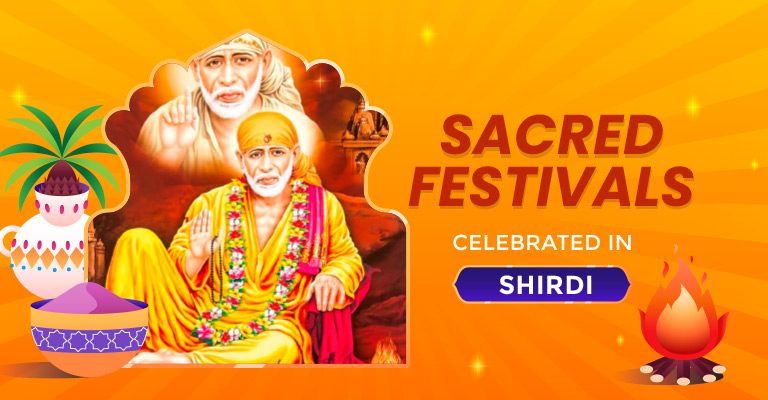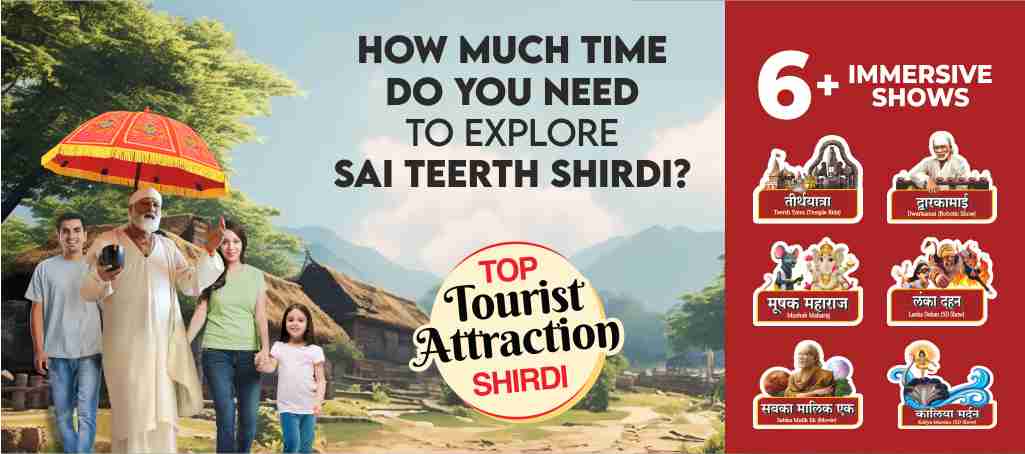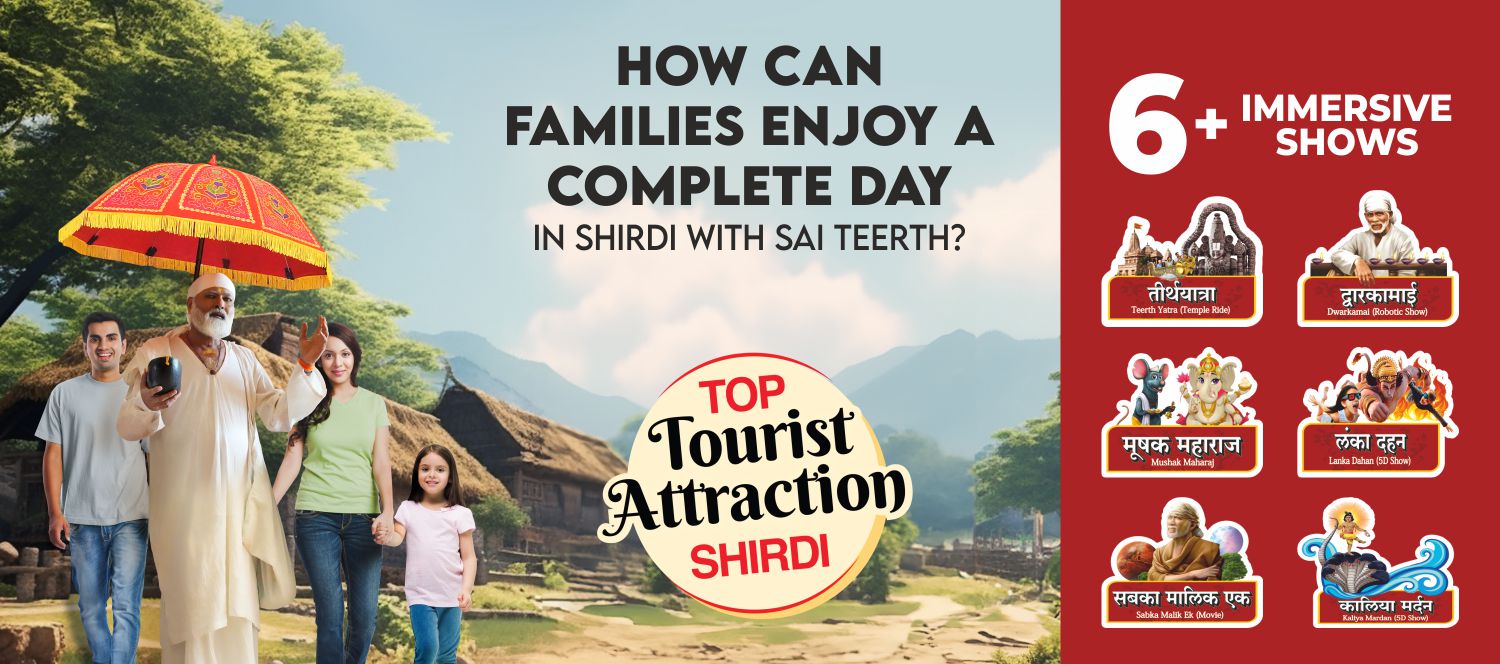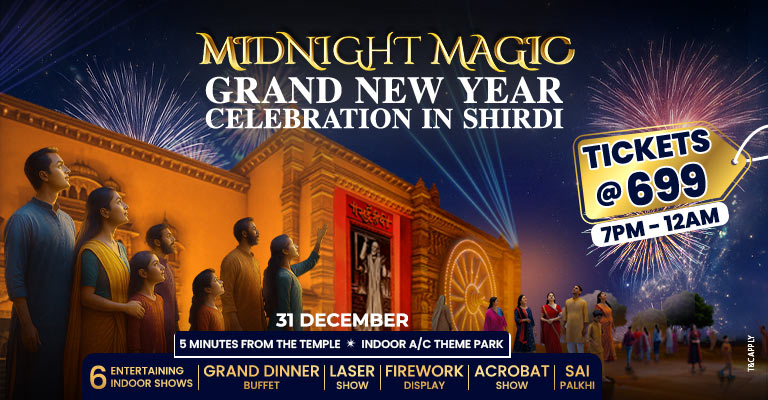Festivals have a unique ability to remind us of our culture and heritage. One can celebrate a festival anywhere, but experiencing it in close proximity to spiritual or religious destinations is definitely more fulfilling. At Saibaba Sansthan Trust or Sai Mandir in Shirdi, several spiritual festivals are celebrated with grace and divinity. Thousands of devotees come for Darshan of their beloved leader and seek His blessings during special festivals.
Festivals at Sai Mandir
Sai Baba is respected and followed for his encompassing thoughts. He believed in Sabka Malik Ek and hence there are different kinds of festivals that are special at the Sai Mandir. In fact, not only at the Sai Temple, but different attractions in Shirdi also cater to the festive occasions. For instance, the Sai Teerth Theme Park is an excellent devotional park that educates visitors on the life of Sai Baba. Using technology this park brings devotees closer to the Sai and instils a stronger emotional bond with spirituality and religion. Festivals are hence celebrated with devotion and sincerity in several locations across Shirdi.
Here is taking a look at some of the most popular festivals celebrated in Shirdi.
Shri Ram Navami Utsav
Ram Navami is the day that Lord Rama was born. It is an important festival in Shirdi as it has a special meaning. In 1897, a devotee named Gopalrao Gund celebrated Urus or a fair as a form of gratitude towards Sai Baba, with whose prayers he was finally blessed with a son. Sai Baba gave him permission to celebrate the Urus on the day of Ram Navami. This was a wonderful gesture by Sai who made it possible for both Hindus and Muslims to come together in the celebrations. Furthermore, in 1912, another devotee Krishnaroa Bhishm had an idea to incorporate Ram Navami celebrations with the Urus fair as well. He seeked permission from Sai, who graciously granted it. Since that day onwards, the Ram Navami celebrations are carried out with grandness and exuberance.
There are two distinct rituals that are performed in Shirdi during Ram Navami. Firstly, a new sack of wheat is kept in Dwarkamai and the old one is sent to Prasadalaya. Secondly, the flags at Dwarkamai are also replaced.
Shri Guru Pournima
Guru Pournima is celebrated on the full moon day of Ashadha, which usually falls during July-August. On this day, Gurus are worshipped and in 1908, Tatya Saheb Nulkar came to Shirdi and worshipped Sai Baba. Baba asked him why he was the only one worshipping him, hence giving permission for other devotees to do the same. From that year onwards, devotees pay gratitude and respect to their saint and guru on this day. In Shirdi, Guru Purnima is a reminder of the Sai, a guru par excellence, who showed his followers the true meaning of being.
On this day special prayers and offerings are carried out at the Sai Mandir.
Vijayadashami or Shri Samadhi Anniversary
Dussehra or Vijaydashami is the holy day when good won over evil. However, in Shirdi, it is also the day when Sai Baba attained Mahasamadhi. It was on Vijayadashmi in 1918 that Sai Baba left the earthly world and crossed over to the next realm. Shri Samadhi Anniversary is one of the most important festivals celebrated in Shirdi. The Sai Temple is open throughout the night during the festival as thousands of devotees make way for blessings. The festival is carried on for three days, with various religious activities lined up for each day. The bathing of the statue, carrying out the palki and meals are planned across the three days.
Thursday Palkhi
From 1910 to 1918, Sai Baba slept in Chavadi every alternate night. A procession from Dwarkamai to Chavadi was taken out every time Baba went to live in Chavadi. To honor this tradition, every Thursday between 7:30 PM to 9:30 PM, a palki or procession is carried out. This procession starts from Samadhi Temple, goes to Dwarkamai, proceeds to Chavadi and then returns to the Sai Mandir. A photo of the Sai, the sacred staff, paduka, the priest and members of Tatya Kote’s family are a part of the palki procession. Devotees are present and pay homage along the entire route of the palki.
Mahashivaratra
Maha Shivaratri is a Hindu festival observed on the 13th/14th night of the month of Phalguna. The festival celebrates the marriage of Lord Shiva and Parvati and it is also associated with the Tandava dance of Shiva. In Shirdi, Mahashivaratra is celebrated with the same zest as elsewhere in the country. There is mention of the worship of Lord Shiva in the Sai Satcharitra, especially the teachings of Sai to Megha who was an ardent devotee of Shiva.
Rang Panchami
Rang Panchami or Falgun Krishan Panchami is a popular festival celebrated in north India. It is observed five days after Holi and is a reminder of the importance of the basic elements of the world, such as air, fire, water, space and earth. In Shirdi a Golden Chariot procession is undertaken on the occasion of the festival and vibrant rangolis are designed. A festival of colors, Lord Krishna and Shiva are worshipped. In Shirdi, prayers are offered to Sai Baba at the Sai Temple. Devotees also splash gulal on each other.
Gudhi Padwa
Gudi Padwa falls on the first day of the Hindu month Chaitra. Historically, it also signifies the victory of Maratha warriors and King Shalivahana. In Shirdi, Gudi Padwa celebrations begin with Baba’s Madhyan Aarti which is followed by the distribution of Maha Prasad.
Hanuman Jayanti
Hanuman Jayanti is celebrated on the day that Hanuman was born. It falls on the 15th day of Chaitra month. In Shirdi, there are various prayers and celebrations held at the Sai Mandir, as well as, across other Hindu temples in the town.
Shravani Monday
Shravani Somwar, also known as Sawan Somwar, is celebrated on Mondays of the month of Shravan. The day is devoted to Lord Shiva and the Shravan month is considered as one of the holiest months by Hindus. In Shirdi too, the holy month of Shravan witnesses an influx of several devotees who seek the blessings of Sai Baba. On Shravani Monday, the Dhup Aarti and other pujas are performed at the Sai Samadhi Mandir.
Gokulashtami
Gokulashtami or Janmashtami is the celebration of the birth of Lord Krishna. At the Sai Mandir, various prayers, including aartis and recitation of bhajans are performed. The idol of a little Krishna is placed near the Sai’s statue and is worshipped by devotees. The placing of the cradle, chariot processions and also breaking of the dahi handi are other various events that are a part of Shirdi’s Gokulashtami celebrations.
Narali Pournima/Raksha Bandhan
Narali Purnima and Raksha Bandhan are celebrated on the same day. Narali means coconut, and the festival is a devotion of the sea lord Varuna. Devotees offer coconuts as gratitude to the sea. Celebrated on the full moon day of the Shravan month, it is also the day when sisters tie Rakhi on the wrist of their brothers, who in turn, vow to always protect them. Raksha Bandhan celebrations in Shirdi are special and as per tradition, devotees tie the first Rakhi to the idol of Sai Baba. Raksha Bandhan is also a big celebration in other locations of Shirdi. For instance, at the Sai Teerth Theme Park the Sai Palki is taken out and children participate in the procession.
Pola
Pola or Bail Pola is celebrated in Maharashtra and other central states of India. The festival honors ox and bull for the important role they play in agriculture and harvest. Pola is observed in the month of Shravan and on this day bulls are bathed and worshipped. At the Sai Samadhi Sansthan, idols of cows are bathed and placed under the statue of Sai Baba. Various pujas, bhajans and aarti are performed by members of the Sansthan and devotees.
Ganesh Chaturthi
Ganesh Chaturthi falls in the month of Bhadrapada and is a ten day festival. It is celebrated with much enjoyment especially in Maharashtra. In Shirdi, an idol of Lord Ganesh is kept inside the Sai Temple. Throughout the festival Ganesh puja, aarti, havan etc. are carried out in Shirdi.
Anant Chaturdashi
Anant Chaturdashi is the final or last day of Ganesh Chaturthi. In Shirdi, Ganesh Visarjan is performed and a procession is also taken out with the idol that is taken for immersion. It is a sacred and holy day, where devotees and priests perform different rituals and prayers.
Kojagiri Pournima
Kojari Purnima is also known as Sharad Purnima. Celebrated in the month of Ashwin it is believed that Lakshmi walks over the earth on this night. It is considered auspicious to stay awake during this night. The idol of Sai Baba is bathed after the morning aarti and adorned with gold ornaments. During the night priests and devotees perform puja and chant mantras and bhajans. Also, there are various programs and puja that worship Indra and Lakshmi. Besides, milk is given to all devotees on this day. The Sai Sansthan extracts hundreds of litres of milk and prasads made from it are distributed to devotees and villagers. The Sai Temple is decorated and lit up on this night.
Narak Chaturdashi
Narak Chaturdashi is celebrated on the day that Lord Krishna and Goddess Kali defeat Naraksura. This auspicious day is also known as Chhoti Diwali and at the Sai Sansthan two main events are associated with this festival. The flags at Dwarkamai are replaced and the old sack of wheat is taken from Dwarkamai and a new one is kept in its place. Devotees wear red color attires on this festive day that marks the victory of good.
Laxmi Pujan
Laxmi Puja is celebrated on amavasya in the month of Ashwayuja. It usually coincides with the third day of Diwali. In Shirdi, special Laxmi puja is held near the idol of Sai Baba at the Sai Sansthan Temple. Priests chant mantras and shlokas and sometimes the live telecast of the puja is also available for devotees.
Deepawali Bali Pratipada
Bali Pratipada takes place on the fourth day of Diwali. It is known by many different names, including Padva, Bali Padyami, Dyutapratipada. This Hindu festival celebrates the return of King Mahabali to earth. Shirdi too is abuzz with the celebrations of Diwali and subsequent festivals. Prayers and aartis at Sai Temple for the Padva pujas are carried out.
Kartiki Ekadashi
Karthik Ekadashi is dedicated to Lord Vishnu. In Shirdi, it is celebrated with the palki procession that starts at 9:15 PM from the Sai Mandir to Dwarkamai to Chavadi. In the temple, devotional songs and prayers are chanted. After the palki returns from the procession to the temple again the Shej aarti is performed.
Tulsi Wedding Programme
Tulsi wedding is a unique festival which celebrates the marriage between Tulsi and Lord Krishna. Tuslis Vivah is on the 12th day after Diwali and the ritual is performed in Dwarkamai. Priests from the Sai Temple come to Dwarkamai and a new Tulsi plant replaces the old one. This plant is decorated and dressed like a bride with bangles and a saree. The marriage takes place in front of devotees who are then offered Bhatasa.
Shri Datta Jayanti
Datta Jayanti celebrates the birth of Dattatreya. At Sai Temple the festivities usually begin with devotees cradling the swing. This is followed by prayers and aarti. A special puja for Dattatreya is also performed and offerings such as, kesari dudh, kesari goda bhaat etc. are offered to the God.
Visiting Shirdi during any of these festivals is special. Though crowded, the spiritual zeal is palpable and devotees are blessed with a sense of religious and divine calm.
Frequently Asked Question
The major festivals celebrated in Shirdi include Ram Navami, Guru Purnima, and Vijayadashami (also known as Sai Baba’s Mahasamadhi Day). These festivals attract thousands of devotees every year.
Ram Navami is celebrated during the Hindu month of Chaitra (usually March or April). It commemorates the birth of Lord Rama and was personally supported by Sai Baba.
Guru Purnima is dedicated to honoring spiritual teachers. In Shirdi, it is celebrated to pay respect to Sai Baba as a Sadguru. Devotees participate in bhajans, processions, and prayers.
Vijayadashami marks the day when Sai Baba attained Mahasamadhi (left his mortal body) in 1918. It is considered a holy day and is observed with great devotion by followers.
Yes, during festivals, the Shri Sai Baba Sansthan Trust organizes special aartis, processions, spiritual discourses, and cultural programs. The entire town is beautifully decorated.










